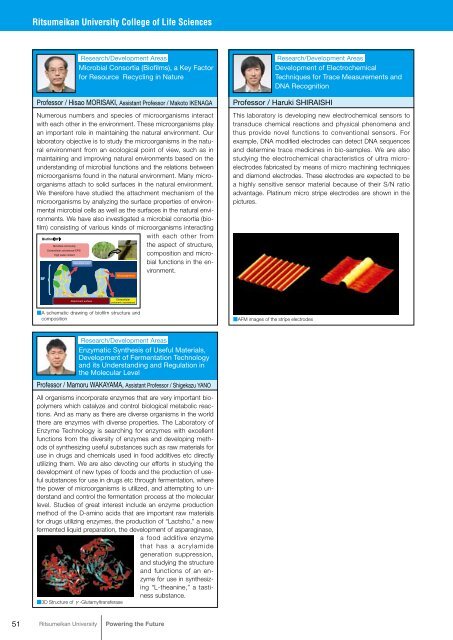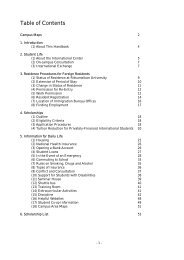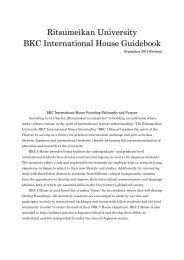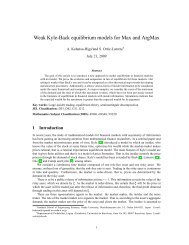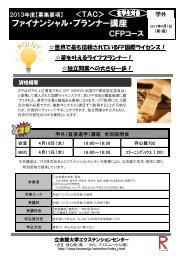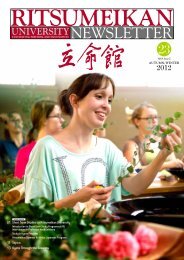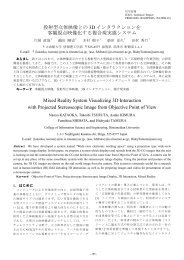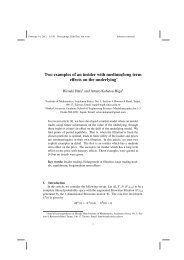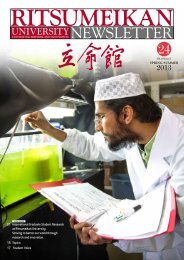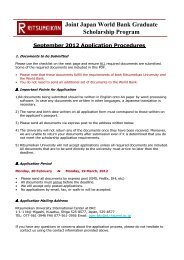Powering the Future - 立命館大学
Powering the Future - 立命館大学
Powering the Future - 立命館大学
You also want an ePaper? Increase the reach of your titles
YUMPU automatically turns print PDFs into web optimized ePapers that Google loves.
Ritsumeikan University College of Life Sciences<br />
Research/Development Areas<br />
Microbial Consortia (Biofilms), a Key Factor<br />
for Resource Recycling in Nature<br />
Professor / Hisao MORISAKI, Assistant Professor / Makoto IKENAGA<br />
Numerous numbers and species of microorganisms interact<br />
with each o<strong>the</strong>r in <strong>the</strong> environment. These microorganisms play<br />
an important role in maintaining <strong>the</strong> natural environment. Our<br />
laboratory objective is to study <strong>the</strong> microorganisms in <strong>the</strong> natural<br />
environment from an ecological point of view, such as in<br />
maintaining and improving natural environments based on <strong>the</strong><br />
understanding of microbial functions and <strong>the</strong> relations between<br />
microorganisms found in <strong>the</strong> natural environment. Many microorganisms<br />
attach to solid surfaces in <strong>the</strong> natural environment.<br />
We <strong>the</strong>refore have studied <strong>the</strong> attachment mechanism of <strong>the</strong><br />
microorganisms by analyzing <strong>the</strong> surface properties of environmental<br />
microbial cells as well as <strong>the</strong> surfaces in <strong>the</strong> natural environments.<br />
We have also investigated a microbial consortia (biofilm)<br />
consisting of various kinds of microorganisms interacting<br />
with each o<strong>the</strong>r from<br />
<strong>the</strong> aspect of structure,<br />
composition and microbial<br />
functions in <strong>the</strong> environment.<br />
Research/Development Areas<br />
Development of Electrochemical<br />
Techniques for Trace Measurements and<br />
DNA Recognition<br />
Professor / Haruki SHIRAISHI<br />
This laboratory is developing new electrochemical sensors to<br />
transduce chemical reactions and physical phenomena and<br />
thus provide novel functions to conventional sensors. For<br />
example, DNA modified electrodes can detect DNA sequences<br />
and determine trace medicines in bio-samples. We are also<br />
studying <strong>the</strong> electrochemical characteristics of ultra microelectrodes<br />
fabricated by means of micro machining techniques<br />
and diamond electrodes. These electrodes are expected to be<br />
a highly sensitive sensor material because of <strong>the</strong>ir S/N ratio<br />
advantage. Platinum micro stripe electrodes are shown in <strong>the</strong><br />
pictures.<br />
■A schematic drawing of biofilm structure and<br />
composition<br />
■AFM images of <strong>the</strong> stripe electrodes<br />
Research/Development Areas<br />
Enzymatic Syn<strong>the</strong>sis of Useful Materials,<br />
Development of Fermentation Technology<br />
and its Understanding and Regulation in<br />
<strong>the</strong> Molecular Level<br />
Professor / Mamoru WAKAYAMA, Assistant Professor / Shigekazu YANO<br />
All organisms incorporate enzymes that are very important biopolymers<br />
which catalyze and control biological metabolic reactions.<br />
And as many as <strong>the</strong>re are diverse organisms in <strong>the</strong> world<br />
<strong>the</strong>re are enzymes with diverse properties. The Laboratory of<br />
Enzyme Technology is searching for enzymes with excellent<br />
functions from <strong>the</strong> diversity of enzymes and developing methods<br />
of syn<strong>the</strong>sizing useful substances such as raw materials for<br />
use in drugs and chemicals used in food additives etc directly<br />
utilizing <strong>the</strong>m. We are also devoting our efforts in studying <strong>the</strong><br />
development of new types of foods and <strong>the</strong> production of useful<br />
substances for use in drugs etc through fermentation, where<br />
<strong>the</strong> power of microorganisms is utilized, and attempting to understand<br />
and control <strong>the</strong> fermentation process at <strong>the</strong> molecular<br />
level. Studies of great interest include an enzyme production<br />
method of <strong>the</strong> D-amino acids that are important raw materials<br />
for drugs utilizing enzymes, <strong>the</strong> production of “Lactsho,” a new<br />
fermented liquid preparation, <strong>the</strong> development of asparaginase,<br />
a food additive enzyme<br />
that has a acrylamide<br />
generation suppression,<br />
and studying <strong>the</strong> structure<br />
and functions of an enzyme<br />
for use in syn<strong>the</strong>sizing<br />
“L-<strong>the</strong>anine,” a tastiness<br />
substance.<br />
■3D Structure of γ-Glutamyltransferase<br />
51 Ritsumeikan University <strong>Powering</strong> <strong>the</strong> <strong>Future</strong>


